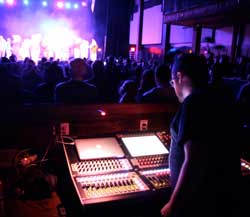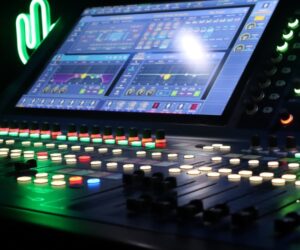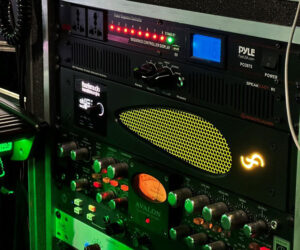Union Transfer is Philadelphia’s newest midsize music space—a former Spaghetti Warehouse restaurant that’s been transformed into one of the city’s most dynamic live venues. Opening its doors in the fall of 2011, this general-admission hall comes complete with multiple bars, ample stage viewing angles, sky-high ceilings, a warehouse vibe, and a movable stage with expandable capacity and state-of-the-art lighting and sound.
Tom George of Eighth Day Sound configured a flexible system for the venue that they could grow into—a DiGiCo SD8-36 at FOH, SD8-24 at monitors and a D Rack—one that would accommodate their average 24-40 inputs per show and allow them to patch in guest consoles and literally to go from a house console to a guest system with a push of a button.
Production manager Tom Shebest, who handles the majority of mixing for bands not travelling with an engineer, was impressed with the recommendation.
“Eighth Day made a convincing case for the DiGiCo SD8,” he recalled. “We looked at other consoles in the same price range and found that DiGiCo offered great value and a lot of extra features for the price. A lot of touring engineers come in that are super comfortable with digital consoles but tend to get a little flustered when switching back between banks a lot.
“The ability to have 36 channels up at one time is great especially with the fact you have three assignable knobs for every channel. The fact that you can have two auxes and pan on 36 channels at any given time is fantastic and something that really isn’t available on any other console.
“The sound quality is fantastic as well for that price,” he states. “It’s the best sounding console that is available digitally; it sounds better than other similar sized consoles on the market. The EQ is really great, too, and does exactly what you want it to do. The effects, especially with the big overdrive update, are so good and offer everything anyone would need right inside the board; we really haven’t had a need to use any outboard gear.
“Everyone’s been able to get what they need within the system which is great because we don’t need to rent any outboard gear to meet most artists riders, and that goes right to our bottom line.”
Monitor engineer Timothy Nichols had limited experience working with the console as a freelance engineer on a variety of festivals and events. He had nothing but rave reviews regarding the console’s intuitive layout, flexible features and audio quality.
“The layout made sense to me immediately, and it seems like most touring engineers using it for the first time can get around just fine,” he explains. “It’s quite easy to customize the layout of the desk for one’s personal preferences. Fader banks can be reassigned, custom fader banks can be created, etc.
“I have a starting template that is both tailored to my preferences and can accommodate the needs of touring engineers without a lot of fuss or making them wait while I reconfigure.
“I love the ‘ripple channels’ feature for input/output soft patching,” Nichols continues. “It saves a lot of time when integrating a touring IEM rig, managing many bands inputs in one show, or when a large input list requires XLR lines to be shared by support acts. When I PFL a monitor mix, the graphic EQ for that mix automatically pops up on the screen…
“Awesome! I don’t have to scroll through menus or multiple screens to access it. This is great for ringing out wedges at soundcheck, or quickly killing unexpected feedback mid-show. The Dynamic EQ is fantastic, too. So many bands use samplers, drum machines, and other electronic sources with unpredictable and inconsistent output signals.
“This lets me dial in extra compression on problem frequencies while leaving the channel’s main compressor more open or even bypassed. Overall, the consoles sound great, especially in tandem with d&b audiotechnik speakers for mains, subs, wedges, and sidefills.”
Another important feature for Nichols, are the console’s knobs. “This really has nothing to do with about sonics, but VERY important for me, is the fact that the knobs on the console feel REAL. They have a bit of resistance to them, so when I turn them it feels more like an analog console, not a plastic toy knob (like the other ones you have used).
“On the DiGiCo, I turn a knob and it’s proportional to the adjustment I see on the LCD. On some other desks it seems like the slightest turn of a knob can change a gain/pan/threshold by 60 dB in the blink of an eye, and I then spend 10 seconds turning it back and forth to make a precise adjustment. Meanwhile I’m missing my next cue or a performer trying to get my attention.”
a DiGiCo




















